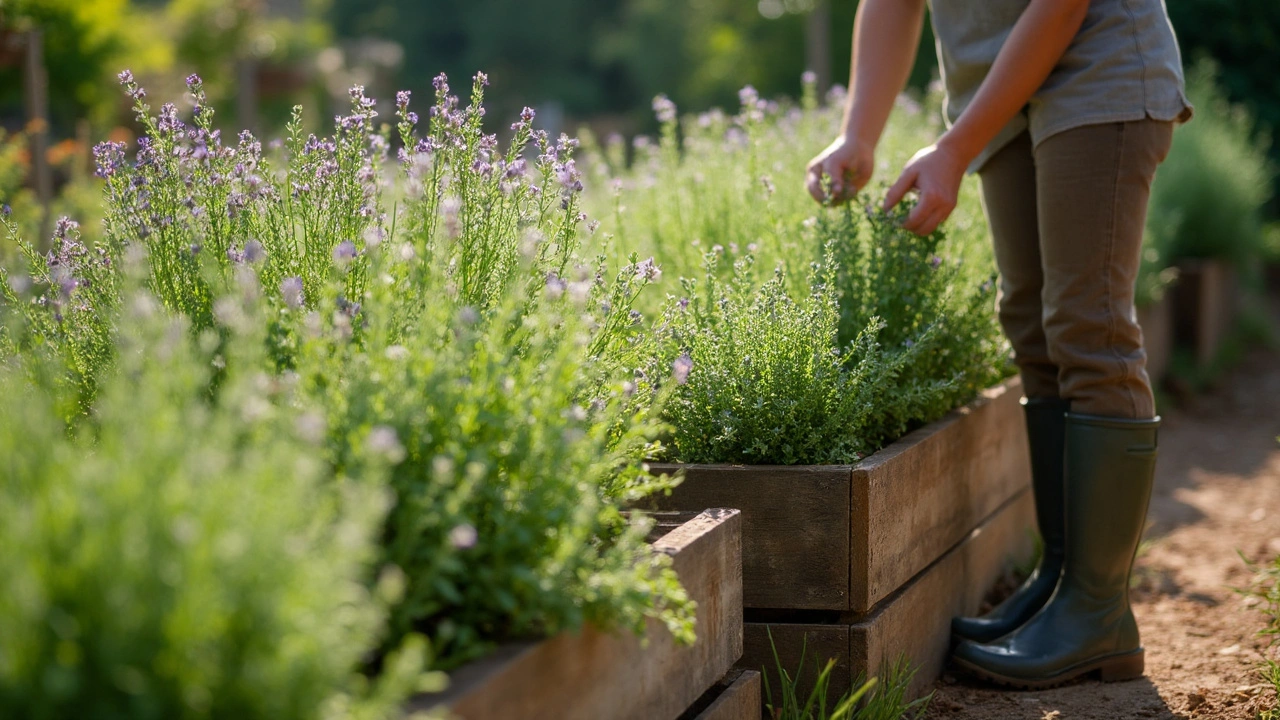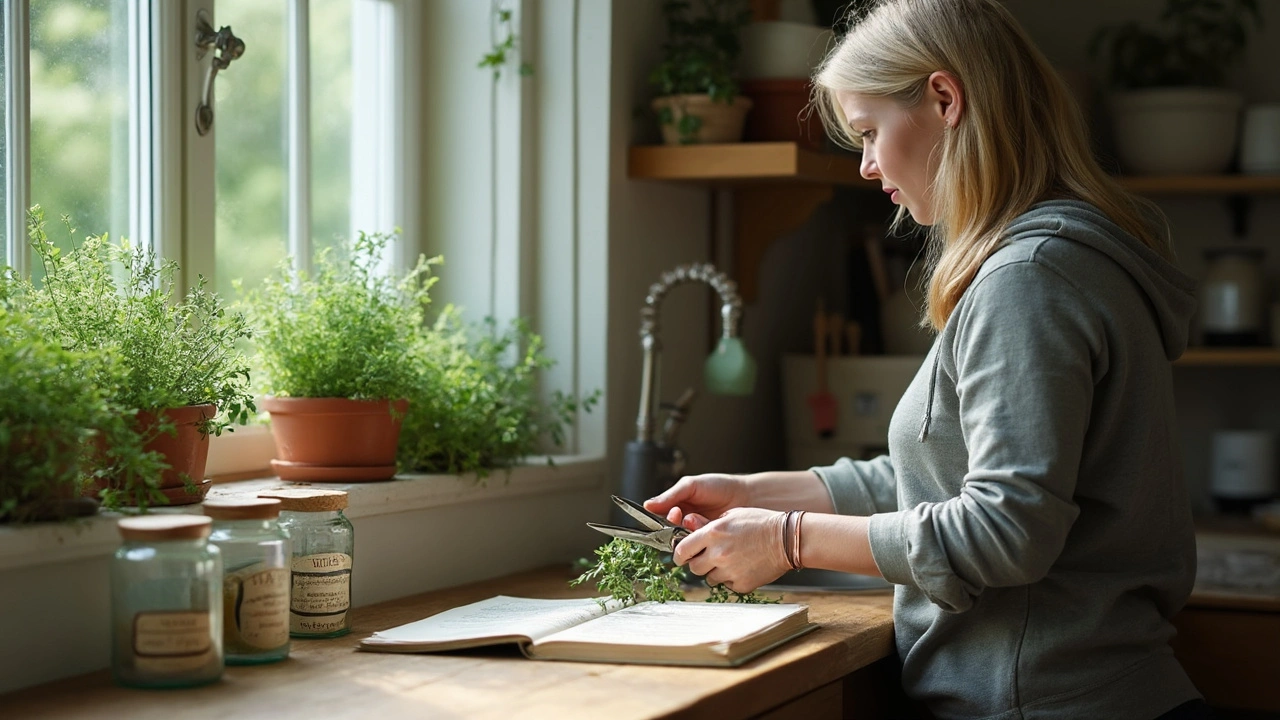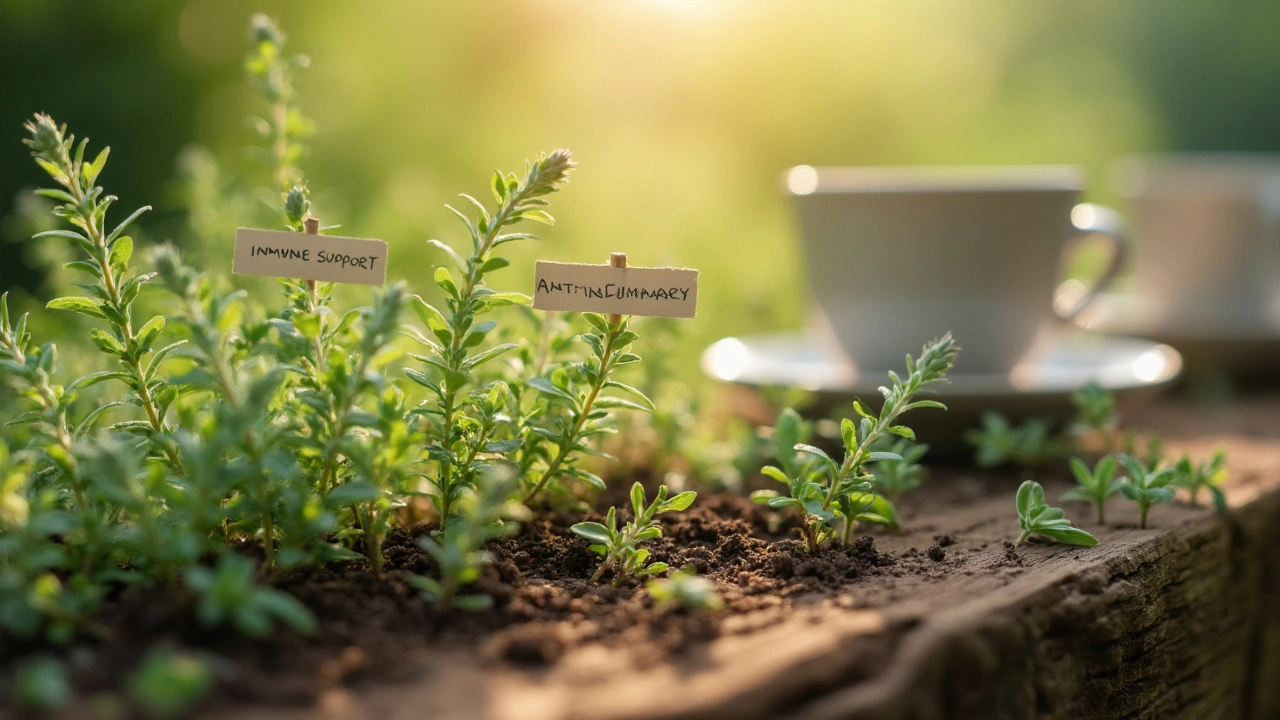How to Grow Wild Thyme at Home for Peak Health Benefits: Soil, Sunlight & Harvesting Secrets

Unlocking Wild Thyme’s Medicinal Magic: Getting the Soil Right
Wild thyme isn’t a diva, but it won’t settle for subpar soil either. If you want your thyme to pack that famous medicinal punch, where you start—quite literally—matters. The most potent wild thyme grows in gritty, well-drained earth. Don’t grab any random bag of potting mix; reach for mixes primed for Mediterranean herbs, or better yet, blend your own: two parts coarse sand, one part compost, and one part garden loam. This isn’t just for show. That craggy, nearly rocky texture helps thyme roots breathe and discourages disease. If you plant wild thyme in dense, muddy soil, don’t be surprised if it sulks and drops flavor. Instead, keep the ground a bit lean. Skip the heavy fertilizers. Wild thyme likes its nutrients in moderation, much like a chef who prefers seasoning to be subtle, not overwhelming. Overfeed it and you dilute those critical essential oils that make the herb so valuable.
Wild thyme prefers soil on the alkaline side. If you garden in acidic soil (think pine needles and ferns), mix in some garden lime once or twice a year. Do you have a patch of gravel or stone in a sunny spot? Perfect. Wild thyme regularly grows through cracks in old walls and gravel driveways across Europe, drawing its signature thymy aroma and potent oils from tough, mineral-rich grit. Want to go the extra mile? Test your soil’s pH with a cheap kit; a sweet spot is 6.5 to 8.0. If you spot yellowing leaves or sluggish growth, dial back the water and don’t reach for fertilizer—check for poor drainage instead. Even grown in pots, thyme thrives best in shallow, wide containers where water doesn’t sit at the bottom for long. Terracotta is a solid pick because it wicks away leftover moisture.
Soil prep isn’t only about nutrients and drainage, though; it’s also about the complex life beneath the surface. Friendly soil bacteria break down organics and make nutrients easier for thyme to grab. Adding a handful of finished compost, or worm castings, infuses this ecosystem with active microbes and trace minerals—little things that can mean a big boost in leaf flavor, color, and medicinal oomph. Some gardeners blend in a pinch of crushed eggshells for calcium, which thyme roots appreciate. If you’re transplanting seedlings or propagating cuttings, try mixing a bit of mycorrhizal fungi into the root zone. Fungi help thyme grab water and nutrients across wider soil territory, and they make stubborn plants settle in faster.
Don’t ignore what’s above ground, either, because that’s where thyme gets its daily drink. After sowing or transplanting, water enough to settle things in, then back off. A layer of fine gravel or sand on top keeps leaves off mud and cuts back on fungal problems. If you want strength in your wild thyme, treat it a little rough—regular droughts and lean soil force the plant to make those strong essential oils. You’re not being cruel. You’re playing into what wild thyme has done for thousands of years on rocky hillsides: it survives, and it concentrates all its goodies in every tiny leaf.

Lighting Up Potency: Sun, Shade, and Placement Hacks for Wild Thyme
Light isn’t just about helping thyme survive—it turbocharges its medicinal content. Wild thyme wants to bask in the brightest light you can give it, ideally at least six hours of full sun per day. When exposed to this sunshine overload, thyme produces more of the special compounds that make it a favorite in herbal remedies—like thymol and carvacrol. These aren’t buzzwords: researchers have shown that thyme grown in southern-facing, sun-baked spots can have double the essential oil content compared to thyme in partial shade. If you want your home crop to match or beat commercial-grade wild thyme, give it an unfiltered blast of sunlight, not gentle dappled patches.
You’ve got a balcony? Windowsill? Rooftop garden? All are great as long as they catch enough rays. If you’re limited to growing thyme indoors, park it right up near a south- or west-facing window and forget the curtains. No sunlight? Pull in a full-spectrum LED or fluorescent grow light, run it about 12 to 14 hours daily, and rotate the pots every few days so they grow evenly. You’ll be surprised: under consistent artificial light, thyme’s stems stay compact, the leaves are darker, and the aroma gets sharper. That’s a clear sign the medicinal power is peaking.
What about temperature swings? Wild thyme can handle cold down to about 10°F (-12°C) and blazing heat above 100°F (38°C), but if you’re aiming for lush, robust growth, a daytime temperature between 65°F and 80°F (18°C to 27°C) is ideal. Wild thyme’s natural home is windswept European hillsides with rapid night-day shifts—so don’t be afraid of a little thermal drama. In fact, letting thyme shiver through the winter (if it’s hardy where you live) actually makes it come back with even bolder flavor and more essential oil when spring returns.
Spacing matters almost as much as light. Give each plant a little room. Crowded thyme gets leggy and yields less potent greens. Dropping seedlings at least eight to twelve inches apart in the garden, or leaving at least four inches between them in a wide pot, lets the light hit every stem. The more sunlight on those leaves, the bigger the boost in those therapeutic oils. You’ll even notice a thicker, bushier cushion of greenery—and less trouble from bugs thanks to good airflow between plants.
For next-level efficacy, harvest thyme from places with the harshest midday sun. This encourages not just oils, but stress compounds that modern science says provide much of thyme’s health benefits. Many folks believe the sunniest branches taste the strongest, have the deepest scent, and show the most vibrant color. It’s not just an old gardener’s tale—the chemical analysis proves it. If you want even more hard numbers, check out the detailed write-up at homegrown wild thyme benefits, where you can see exactly how environment shapes medicinal power. If you’re desperate for maximum punch, don’t grow in shade and expect miracles. Wild thyme’s healing edge is a literal product of the sun.

When and How to Harvest for Maximum Medicinal Potency
This is the part a lot of newbies get wrong. You spend months pampering your thyme, then snip leaves at the wrong time and wonder why the tea lacks bite or the oil smells faint. Here’s the truth: harvesting at the right moment changes everything. Wild thyme peaks—chemically—just as it starts to bloom. You’ll spot tiny purple-pink flowers forming on the ends of stems. In most regions, this means late spring to early summer. You want to catch the plant when those flowers are newly open but not fully faded. The essential oils and antioxidant-rich compounds are at their highest right then.
The best time of day to snip wild thyme is late morning, once the dew has evaporated but before the blazing heat of midday. The plant is fully awake, oils are concentrated in the leaves, and you won’t risk mildew from morning damp. Use sharp scissors or garden shears, and cut stems two to four inches from the tips, gathering only as much as you need unless you’re planning to dry a harvest for future use. Never trim more than one-third of the plant at a time—this keeps your thyme healthy and guarantees regrowth for another round in a few weeks.
If you aim to store wild thyme, drying deserves special care. Air-drying is best to keep oils intact. Spread cut stems in a single layer on a rack or tie several into small loose bundles and hang upside down in a well-ventilated spot away from sun. Direct light can burn off precious oils. If you absolutely must use a dehydrator, set it below 95°F (35°C) so you don’t fry those medicinal goodies. Fully dried thyme should snap, not bend, when you break a stem. Store it in air-tight jars away from heat and light to keep the flavor and potency alive for months.
Fresh wild thyme is a different animal altogether. If you add it to teas, tonics, or food, crush the leaves just before use. That popping herb smell means you’ve cracked the tiny oil glands inside, unlocking the full medicinal arsenal. You can also infuse wild thyme in olive oil or honey—just drop fresh sprigs into a sterilized jar, cover with oil or honey, and let it steep for two to four weeks, flipping the jar now and then. The oils leach out, loading your infusion with all the wild thyme’s healthful components. People have been doing this for centuries, and modern tests back it up: infusions from freshly harvested thyme beat store-bought dried herbs every time for both flavor and effect.
Thinking about making an extract or tincture? Harvest thyme right after a sunny morning for maximum oil. Chop finely, pack into a clean jar, and cover with high-proof vodka or brandy. Keep it dark and shake once a day for a month. Strain, bottle, and you’ve captured a concentrated version of what wild thyme can do. There’s a reason this herb’s reputation has lasted since Greek and Roman times. The right harvest, done at the right moment, means seriously potent medicine in every drop or leaf.

Krishna Garimella
July 18, 2025 AT 04:25Wild thyme is indeed a fascinating herb with so much to offer health-wise! 🌿 What really excites me is how versatile it is, not only in cooking but also as a natural remedy. When I'm growing it at home, I find that ensuring plenty of sunlight really helps it thrive, and it often surprises me how much more aromatic the leaves become!
Also, the soil plays such a critical role. I prefer a well-draining, slightly alkaline soil to mimic its natural habitat. One thing I wanted to ask—is anyone else experimenting with indoor wild thyme cultivation? The humidity and light control definitely impact the growth.
This post's tips about harvesting at the right time are invaluable. There’s a sweet spot when the oil content peaks, and picking just before flowering seems best. Does anyone have personal techniques for prolonging the herb's shelf life after harvest? 🤔
abigail loterina
July 20, 2025 AT 10:26This guide is super helpful! Growing wild thyme at home can feel daunting, but breaking down soil, sunlight, and harvesting makes it way easier to follow. I've always enjoyed using thyme in cooking but recently started exploring its medicinal benefits.
One tip I love sharing is using a small container indoors near a south-facing window. Wild thyme absolutely loves the sunlight and tends to grow quite well with just a few hours of bright light. Plus, watering is easier to control inside, preventing the roots from getting soggy.
Thanks for emphasizing hands-on advice. It encourages more people to try growing these potent herbs at home, which is such an empowering step towards wellness! Anyone else on here just starting their gardening journey with wild thyme?
Roger Cole
July 22, 2025 AT 18:00This article covers the essentials clearly. Wild thyme does best in a sunny spot with well-drained soil, and harvesting just before the flowers bloom guarantees the best flavor and medicinal oils.
From my experience, it's important not to overwater. These plants are drought tolerant and can rot easily if the soil stays wet. Also, pruning encourages fuller growth rather than letting the plant get leggy.
Glad to see reliable practical advice shared here so folks can yield the best results. Has anyone successfully grown wild thyme on an apartment balcony? Curious about how much direct sun is needed for strong growth.
Artie Alex
July 25, 2025 AT 01:33Honestly, this whole 'grow wild thyme for peak health benefits' premise is vastly oversimplified and borderline misleading. The biochemical complexity of the phytochemicals contained within wild thyme requires far more rigorous scrutiny before anyone should trust anecdotal claims about its medicinal punch.
Without standardized soil nutrient profiles and controlled climatic variables, any results remain anecdotal at best. Additionally, the post ignores potential spectrums of allergens or interactions with pharmaceutical compounds, which are critical in holistic health discussions.
People need to approach the "potent remedy source" narrative critically, lest enthusiasm cloud reason. I invite the author and fellow gardeners to share validated data regarding phytochemical concentrations under varied growing conditions.
nalina Rajkumar
July 27, 2025 AT 09:06I'm so happy to see more posts encouraging growing herbs like wild thyme! 😊 It’s such a simple herb but packs a lot of benefits.
One thing I always remind beginners is not to stress too much about perfect soil or conditions. Wild thyme is pretty forgiving and thrives with some basic care. Just make sure it’s somewhere sunny and the soil drains well, and you’re good!
Also, harvesting regularly actually helps the plant stay bushy and produce more leaves. I love using a small pair of scissors to snip above the nodes. It’s so rewarding to have fresh herbs at hand!
Anyone else loves the smell of wild thyme? It’s so calming! 🌿✨
kuldeep singh sandhu
July 29, 2025 AT 16:40Hey all, I must say the article makes wild thyme sound a bit too perfect. Growing herbs indoors can be hit or miss due to variables no one talks about.
Humidity, airflow, soil pH, not to mention pest control—these are often overlooked. Throw in fluctuating daylight hours in winter, and maintaining potent herb levels is challenging.
I dare say one needs more than just sunlight and soil to get the medicinal punch promised here. Anyone experienced wild thyme failing despite following these so-called 'secret' tips?
Ragha Vema
August 1, 2025 AT 00:13This is exactly the kind of info I want to share! Wild thyme isn’t just some ornamental herb, it’s a game-changer. The fact that you can cultivate it indoors makes me think about the potential for homegrown health revolutions. 🌱
I do wonder about the harvesting window though. The article mentions timing for peak benefits but how precise do we have to be? Is it like a one-day window or more forgiving?
Also, does anyone know if wild thyme varieties differ significantly in their medicinal compounds? Would love a deep dive on that.
abigail loterina
August 3, 2025 AT 07:46Replying to the question about the harvesting window — from my experience, there’s definitely some wiggle room. The oils peak just before full bloom, but you can still harvest a few days either side without losing much potency.
I think it varies by climate too, so gardeners should observe their plants closely. If you catch the flowers just starting to open, that’s usually the sweet spot. Overripe flowers may lead to diminished flavor and medicinal qualities.
And about varieties, yes! Different types of wild thyme have slightly different aromas and oil profiles. It’s fun to experiment and see which you prefer for cooking or remedies.
Hope that helps! Anyone else have tips on selecting thyme varieties for health benefits?
Steve Batancs
August 5, 2025 AT 15:20Let’s be clear here, the fuss over wild thyme is unnecessary hype. Sure, it’s a decent herb, but the medicinal qualities are grossly exaggerated by many to push home gardening trends.
The real deal grows in specific regions with expert cultivation methods, nothing home growers can replicate easily. Your typical backyard patch or windowsill pot won’t match up despite sun and soil advice.
Folks need to temper expectations. These homegrown “potent remedies” are mostly placebo. Focus instead on proven supplements and medical treatments.
Adam Baxter
August 12, 2025 AT 14:00Hey everyone, just wanted to throw in that I’ve been growing wild thyme indoors for about a year now and it’s been a fantastic experience. It really likes when I rotate the pot every few days so all sides get light. Simple but effective!
I also learned the hard way not to overwater it. Those little leaves can get super sad if the roots sit in water. Humidity hasn’t been a big issue for me, but I live in a pretty dry state.
Another tip: trimming every couple weeks encourages fresh growth and prevents it from getting woody. I use the harvest in teas and cooking and definitely notice the aromatics are stronger when I follow these rituals.
Totally recommend giving it a try, even if you’re a beginner!
Scott Mcquain
August 16, 2025 AT 01:20While I appreciate the enthusiasm, it’s important to acknowledge the limits of backyard herbalism for medicinal purposes. Wild thyme is useful, no doubt, but relying heavily on it without understanding its pharmacokinetics and interaction potential is unwise.
Scientific studies back some claims, yet dosage and extraction methods lead to variability. Proper drying and storage also influence the integrity of the active compounds. So folks should combine practical growing tips with cautious respect for its medicinal scope.
It’s all about balancing appreciation of traditional knowledge with modern scientific rigor.